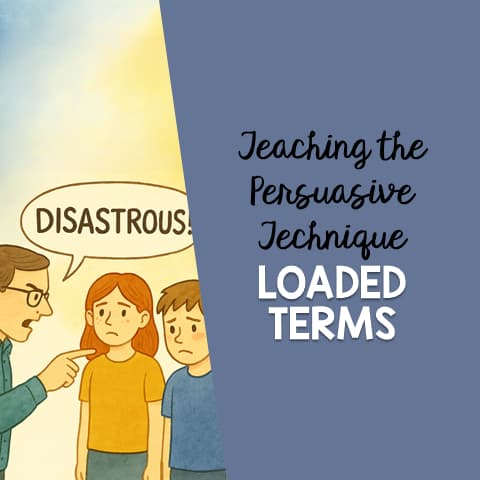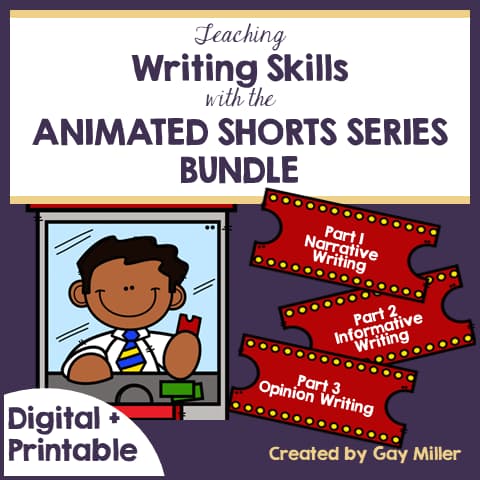
This is the third post in my series on teaching persuasive techniques (sometimes called propaganda devices). In this lesson, we’ll focus on loaded terms—words designed to stir emotions—and explore how they’re used in commercials to influence an audience. To make the lesson even more practical, I’ve also included a short video on using analogies in argument writing, giving your students another powerful strategy to add to their persuasive writing toolbox.
Handout
This handout includes all the activities in a student-ready format. Just print and teach.
What Are Loaded Terms?
Loaded terms are words or phrases that carry strong emotional weight. Advertisers, politicians, and writers use them to create powerful reactions in readers or listeners.
- Politicians might use words like freedom fighter instead of rebel or terrorist, depending on the message they want to send.
- Advertisements often use loaded words to make a product sound more desirable (or to make competitors sound worse).

Student-Friendly Definition
Loaded terms are words that make people feel strong emotions, positive or negative, about a topic.
Questions to Ask When Spotting Loaded Terms
- What connotation is used: positive, negative, or neutral?
- Does the vocabulary show authority or expertise?
- Are idioms or figurative phrases used?
- Do the words spark emotions such as pride, fear, or compassion?
Examples of Loaded Terms in Advertisements
Expedia “Train”

Phrases include:
- influence narrow minds
- bridge continents
- puncture prejudice
- keep peace
The emotional effect: The audience feels inspired and important, as if travel changes the world.
Jeep “Whole Again”

Phrases include:
- influence narrow minds
- bridge continents
- puncture prejudice
- keep peace
The emotional effect: The audience feels inspired and important, as if travel changes the world.
Evony: The King’s Return

Powerful, battle-ready phrases include:
- Brave fellows, your country is at stake.
- Fight for liberty.
- Let Your Reign Begin.
The emotional effect: Stirring bravery and loyalty.
Wendy’s “Cold Storage”

Powerful, battle-ready phrases include:
- Brave fellows, your country is at stake.
- Fight for liberty.
- Let Your Reign Begin.
The emotional effect: Stirring bravery and loyalty.
Kia “The Perfect Getaway”

Descriptive and dramatic language include:
- driving 200 mph
- sniper
- missile launcher
- top-secret mission
The emotional effect: Excitement and danger, compared to the calm of a real snowy mountain drive.
Classroom Activities for Teaching Loaded Terms

Here are a few ways to make this lesson interactive:
Loaded Term Hunt
Play short clips of commercials (like the ones above). Have students underline or list the loaded terms they hear.
Loaded Term Rewrite
Give students a neutral sentence (e.g., The car drives fast.). Ask them to rewrite it using loaded terms that make it sound positive (The car zooms with thrilling speed.) or negative (The car recklessly races down the road.).
Loaded Term Writing Prompt
Provide a topic (school uniforms, recycling, or cafeteria food). Ask students to write a short ad using loaded terms to persuade classmates.
Analogies in Argument Writing (Video Lesson + Activity)
While loaded terms appeal to emotions, analogies strengthen arguments by making complex ideas easier to understand.

📺 Video Lesson: Analogies in Argument Writing
In this interactive video, students:
- Complete a cloze definition of “analogy.”
- Learn three rules for writing strong analogies.
- See examples of good analogies (and one non-example).
- Write their own analogy using the sentence starter:
- “My argument is ____. It’s like ____ because ____.”
This pairs perfectly with loaded terms: students see how persuasive writing uses both emotional word choice and logical comparisons to convince readers.
Ready to jump in?
This resource includes everything you need to teach the full lesson with ease:
- Graphic organizers for each persuasive technique in the series
- Direct links to the recommended advertisements featured in the post
- A printable response sheet for students to analyze the ads
- The Analogies in Argument Writing organizer in both printable and Google Slides formats
- A link to the full lesson video, available on YouTube and Vimeo
Visit all the posts in this series.
See the product that inspired this post.
Are you looking for a fun way to teach writing skills? This series teaches narrative, informative, and opinion writing with animated short films your students are sure to love!



